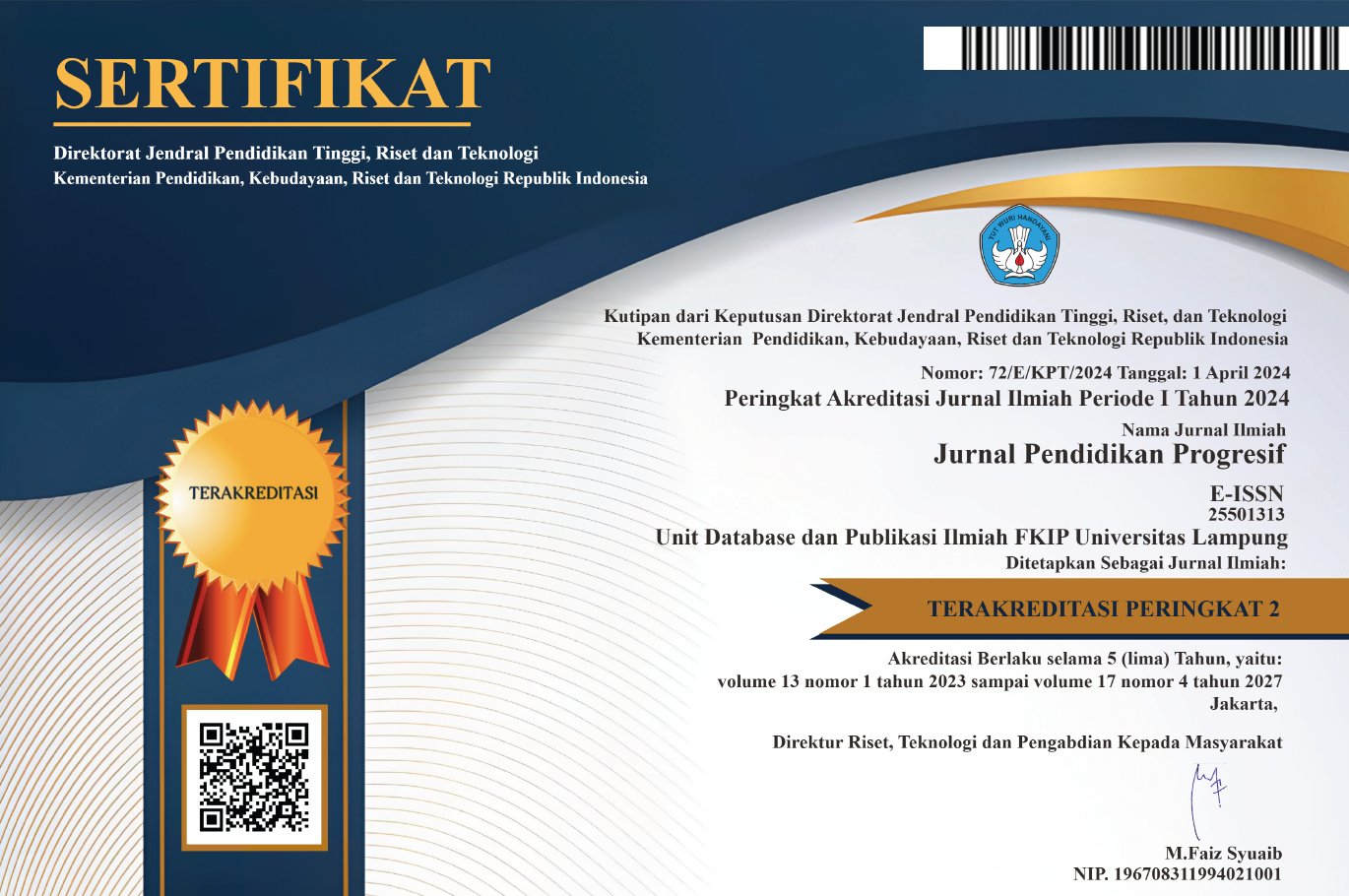Classroom Language: Preparing the Pre-Service Teachers for Successful Classroom Interactions
 Country:
Country:
(1) Universitas Negeri Surabaya, Indonesia
(2) Universitas Negeri Surabaya, Indonesia
| Metrics→ |
| Indexing Site→ |
Copyright (c) 2025 Ririn Pusparini, Esti Kurniasih
This study aims to investigate how pre-service teachers (PSTs) employ classroom language for Opening, Running, and Closing the Lesson in the classroom. A qualitative method was applied where the data were gathered through questionnaire sheets and an observation checklist. Thirty students in the second year of the English Education Study Program in Surabaya, Indonesia, participated in this study. The findings reveal that PSTs have applied classroom languages appropriately and successfully for eight components of basic teaching skills. Nevertheless, three components that do not vary are the language expressions attributed to opening the lesson for checking attendance, varying stimuli for setting and cleaning up teaching media, and organizing the small group discussion. The findings can be valuable input for the teacher of an education program to be more concerned with the teacher candidates' language variations to prepare them for successful classroom interactions.
Keywords: classroom language, pre-service teachers, classroom interactions.
DOI: http://dx.doi.org/10.23960/jpp.v13.i2.202304
Allday, R. A., & Pakurar, K. (2007). Effects of teacher greetings on student on-task behavior. Journal of Applied Behavior Analysis, 40(2), 317–320. https://doi.org/10.1901/jaba.2007.86-06
Bella, M. S., & Zainil, Y. (2020). An analysis o f teachers’ classroom language at SMPN 4 Muara Bungo. Journal of English Language Teaching, 9(4), 644–651. https://doi.org/10.24036/jelt.v9i4.110200
Bilash, O. (2011). Best of Bilash: Improving second language education. https://sites.educ.ualberta.ca/staff/olenka.bilash/Best%2520of%25%0A20Bilash/competencyperformance.html
Clunies-Ross, P., Little, E., & Kienhuis, M. (2008). Self-reported and actual use of proactive and reactive classroom management strategies and their relationship with teacher stress and student behaviour. Educational Psychology, 28(6), 693–710. https://doi.org/10.1080/01443410802206700
de Jong, R., van Tartwijk, J., Wubbels, T., Veldman, I., & Verloop, N. (2013). Student teachers’ discipline strategies: Relations with self-images, anticipated student responses and control orientation. Educational Studies, 39(5), 582–597. https://doi.org/10.1080/03055698.2013.814562
Ellis, R. (2008). Classroom interaction and second language acquisition. In the study of second language acquisition (p. Oxford: Oxford University Press). Oxford: Oxford University Press.
Emmer, E., Evertson, C., & Worsham, M. (2006). Classroom management for middle and high school teachers (7th ed.). . Boston: Pearson.
Greig, A. (2000). Student-led classes and group work: A methodology for developing generic skills. Legal Education Review, 114418(02).
Habibi, N. (2017). The Use of flashcards in improving vocabulary mastery of students with disability. Inklusi, 4(2), 197. https://doi.org/10.14421/ijds.040203
Hadiatmi, I. N., Wilian, S., & Yusra, K. (2020). Classroom languages as used by English teachers. Jurnal Ilmiah Pendidikan Indonesia, 2(1), 81–90. https://jipi.unram.ac.id/index.php/jipi/article/view/40/38
Hapsari Oka, I. A. P. P., & Artini, L. P. (2022). The purpose of the use classroom language. Jurnal Pendidikan Bahasa Inggris Undiksha, 9(3), 241. https://doi.org/10.23887/jpbi.v9i3.43105
Krashen, S. D. (1982). Second language acquisition theory. Principles and practice in second language acquisition, 9–32. In Pergamon Press Inc (Vol. 33, Issue 1). https://doi.org/10.3102/00346543033001038
Leona, N. L., van Koert, M. J. H., van der Molen, M. W., Rispens, J. E., Tijms, J., & Snellings, P. (2021). Explaining individual differences in young English language learners’ vocabulary knowledge: The role of Extramural English Exposure and motivation. System, 96, 102402. https://doi.org/10.1016/j.system.2020.102402
Paramita, P., Sharma, U., & Anderson, A. (2020). Indonesian teachers’ causal attributions of problem behaviour and classroom behaviour management strategies. Cambridge Journal of Education, 50(2), 261–279. https://doi.org/10.1080/0305764X.2019.1670137
Richards, J. C., & Lockhart, C. (2007). Reflective teaching in second language classrooms. In Cambridge University Press (Vol. 79). Cambridge University Press. https://doi.org/10.2307/329404
Sharafi-Nejad, M., Raftari, S., Ismail, S. A. M. M., & Eng, L. S. (2016). Prior knowledge activation through brainstorming to enhance Malaysian EFL learners’ reading comprehension. International Journal of Linguistics, 8(2), 187. https://doi.org/10.5296/ijl.v8i2.9397
Sujarwo. (2020). Students’ perceptions of using machine translation tools in the EFL classroom. Al-Lisan Jurnal Bahasa, 5(2), 230–241.
Van Canh, L., & Renandya, W. A. (2017). Teachers’ English proficiency and classroom language Use: A conversation analysis study. RELC Journal, 48(1), 67–81. https://doi.org/10.1177/0033688217690935
Whitehead, S. J. (2021). “I thought we weren’t in Spain!”: Discursive negotiations of realness in a foreign language classroom. System, 100(August 2020), 102532. https://doi.org/10.1016/j.system.2021.102532
Wichadee, S. (2011). Developing the self-directed learning instructional model to enhance English reading ability and self-directed learning of undergraduate students. Journal of College Teaching & Learning (TLC), 8(12), 43. https://doi.org/10.19030/tlc.v8i12.6620
Widyahening, E. T. (2018). Penggunaan classroom language dalam pembelajaran bahasa Inggris bagi guru SDN 01 Suruh Tasikmadu Karanganyar [The application of classroom language in teaching English by an elemantary teacher of SDN 01 Suruh Tasikmadu Karanganyar]. Adiwidya, II(2), 159–166.
Willis, J. (1981). Teaching English through English (Vol. 8).
Woodcock, S., & Reupert, A. (2013). Does training matter? Comparing the behaviour management strategies of pre-service teachers in a four-year program and those in a one-year program. Asia-Pacific Journal of Teacher Education, 41(1), 84–98. https://doi.org/10.1080/1359866X.2012.753991
Yphantides, J. (2009). Studcnt use of Japanese in the EFL classroom. Accents Asia, 3(2), 1–26.
Zarei, A. A., & Afshar, N. S. (2014). Multiple intelligences as predictors of reading comprehension and vocabulary knowledge. Indonesian Journal of Applied Linguistics, 4(1), 23–38. https://doi.org/10.17509/ijal.v4i1.598
Refbacks
- There are currently no refbacks.

This work is licensed under a Creative Commons Attribution-ShareAlike 4.0 International License.
View My Stats


